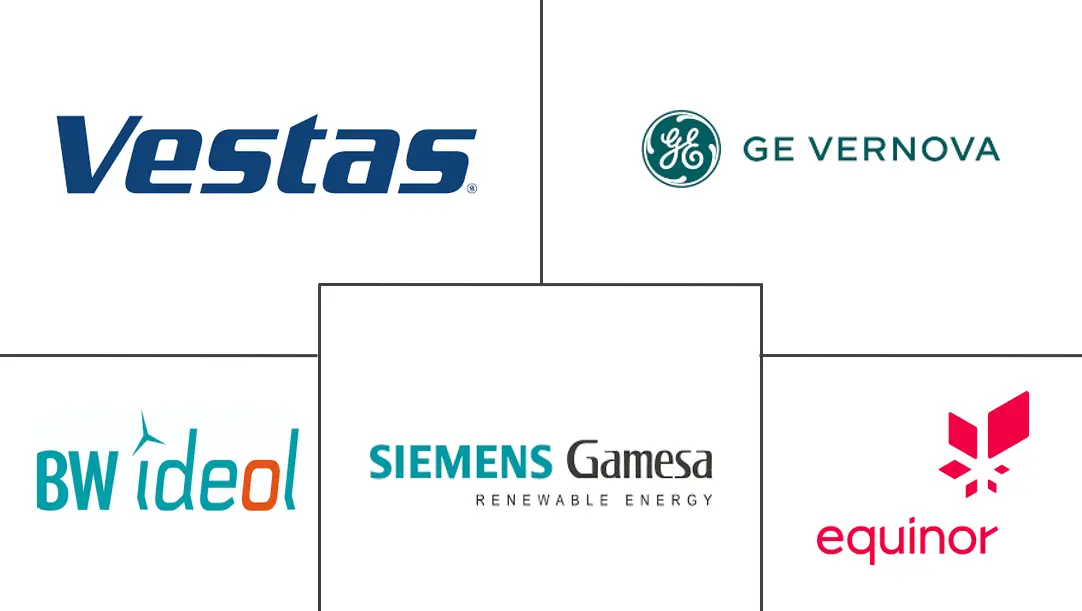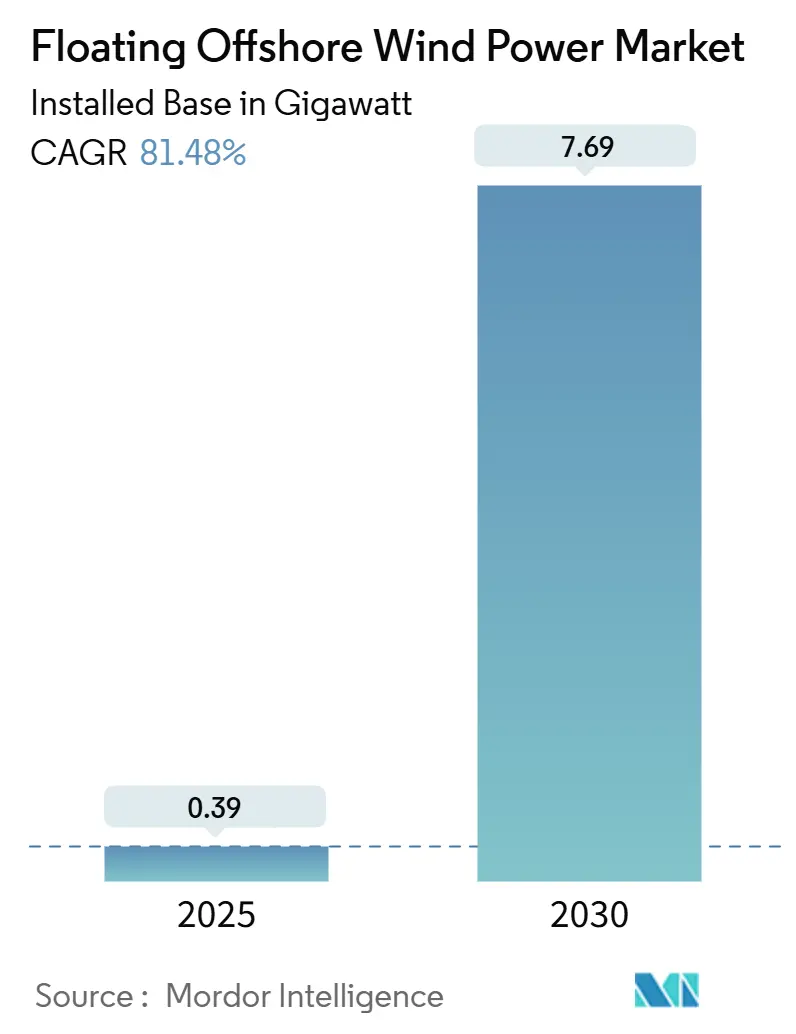
Floating Offshore Wind Power Market Analysis by Mordor Intelligence
The Floating Offshore Wind Power Market size in terms of installed base is expected to grow from 0.39 gigawatt in 2025 to 7.69 gigawatt by 2030, at a CAGR of 81.48% during the forecast period (2025-2030).
This expansion reflects the sector’s ability to tap deeper-water sites that hold 80% of global offshore wind resources, while rapid cost compression is pushing the Levelized Cost of Energy toward €50-100/MWh by 2030.(1)Enerdata, “Offshore Wind LCOE Outlook,” enerdata.net As the floating offshore wind market enters a commercial phase, supply chains built around conventional fixed-bottom projects are being re-tooled to handle Semi-Submersible and Spar-Buoy platforms that can be assembled quayside and towed to depths exceeding 1,000 m. Developers are also pivoting to turbines above 15 MW to spread foundation and installation costs over larger generation envelopes. Regional policy adds momentum: Europe’s revenue-stabilizing Contracts for Difference (CfD) reforms, the United States’ “Floating Offshore Wind Shot,” and Japan–Korea lease auctions are unlocking capital, while oil-and-gas platform conversions in the Gulf of Mexico highlight cross-sector synergies. These forces, combined with emerging hydrogen co-location schemes that absorb surplus power, position the floating offshore wind market for significant scale-up this decade.
Key Report Takeaways
- By water depth, transitional (30 to 60 m) sites led with 55% floating offshore wind market share in 2024; the deep-water segment (Above 60 m) is projected to expand at an 88% CAGR through 2030.
- By platform type, Semi-Submersibles captured 57% of the floating offshore wind market in 2024, while Spar-Buoy units are forecast to accelerate at an 84% CAGR to 2030.
- By turbine rating, the 5 to 10 MW class accounted for 53% of the floating offshore wind market size in 2024; turbines above 15 MW are slated to grow at an 84% CAGR during 2025-2030.
- By application stage, pre-commercial pilots held 68% of the floating offshore wind market size in 2024, whereas utility-scale plants are on course for a 93% CAGR to 2030.
- By geography, Europe held a 92% market share in the floating offshore wind market in 2024; the Asia-Pacific region is the fastest-growing, advancing at a 156% CAGR through 2030.
Global Floating Offshore Wind Power Market Trends and Insights
Drivers Impact Analysis
| Driver | (~) % Impact on CAGR Forecast | Geographic Relevance | Impact Timeline |
|---|---|---|---|
| Growing Lease Awards in U.S. & APAC Deep-Water Zones | +18.5% | United States, Japan, South Korea, Taiwan | Medium term (2-4 years) |
| Rapid Turbine Upsizing to 15-20 MW Class Reducing LCOE | +22.3% | Global | Short term (≤ 2 years) |
| Oil & Gas Platform Conversions Unlocking Gulf of Mexico Supply Chain | +8.7% | United States | Medium term (2-4 years) |
| EU & UK CfD Reform Boosting Bankability | +12.4% | Europe | Short term (≤ 2 years) |
| National Hydrogen Roadmaps Creating Co-location Demand | +6.9% | Europe, Asia-Pacific | Long term (≥ 4 years) |
| Asian Cable-Vessel Build-out Shortening Installation Schedules | +9.2% | Asia-Pacific | Medium term (2-4 years) |
| Source: Mordor Intelligence | |||
Growing Lease Awards in U.S. & APAC Deep-Water Zones
A surge of deep-water lease auctions is reshaping the floating offshore wind market, with the U.S. Bureau of Ocean Energy Management preparing multiple sales through 2025 and targeting 15 GW of floating capacity by 2035. The federal “Floating Offshore Wind Shot” pairs these leases with research and development aimed at achieving 70% cost reductions.(2)U.S. Department of Energy, “Floating Offshore Wind Shot,” energy.gov In the Asia-Pacific region, South Korea’s 1.8 GW tender and Japan’s entry into the U.S. cost-reduction initiative underscore how bilateral partnerships are building a 244 GW global pipeline. Developers view these awards as stepping stones from demonstration to multi-GW arrays, prompting early investments in port upgrades, cable factories, and installation vessels. Therefore, policy continuity across the Pacific Rim is locking in bankable revenue streams while pushing the floating offshore wind market closer to gigawatt-scale annual additions.
Rapid Turbine Upsizing to 15-20 MW Class Reducing LCOE
Moving from a 6-10 MW baseline to 15-20 MW turbines cuts per-megawatt foundation counts by up to 40%, directly lowering steel and mooring use. Research on Spanish Atlantic sites finds that 15 MW machines can drive LCOE to 100 €/MWh in favorable conditions.(3)Equinor, “Hywind Tampen—World’s Largest Floating Wind Farm,” equinor.com Manufacturers such as Siemens Gamesa and Vestas have accelerated their prototyping schedules to secure an early-mover advantage, while port owners lengthen their quays and reinforce cradle structures to handle 120-m blades. The upsizing wave also reshuffles vessel demand: only a handful of next-generation WTIVs can install nacelles weighing over 1,200 tons, creating new charter-rate spikes that force developers to lock in capacity years in advance. Overall, turbine scale-up is pivotal to meeting national cost-reduction targets and sustaining the blistering growth of the floating offshore wind market.
Oil & Gas Platform Conversions Unlocking Gulf of Mexico Supply Chain
Repurposing idle platforms offsets steel price volatility and accelerates permitting because foundation footprints already exist. A decision-framework study shows that retrofit IRRs exceed 12% when lifespans are extended by 25 years, and topsides are converted to floating substations.(4)National Renewable Energy Laboratory, “Offshore Turbine Trends 2025,” nrel.gov The Gulf of Mexico’s dense network of fabrication yards presents an instant critical mass for mooring chains, anchors, and dynamic cables, cutting logistics costs compared to greenfield yards. Europe mirrors this logic: North Sea operators are redeploying semi-sub structures as testbeds for 2-MW demonstrators, validating load cases before scaling to 15-MW turbines. These synergies help the floating offshore wind market absorb oil-service labor while de-risking schedules, which is crucial during the current steel-price swing cycle.
EU & UK CfD Reform Boosting Bankability
The UK’s 2024 overhaul of CfD rules introduced phased construction windows and a Clean Industry Bonus that incentivizes domestic fabrication. Contract allocations covering 9.6 GW of low-carbon capacity included a 400 MW floating wind tranche, underscoring lender confidence once price-fluctuation risk is removed. Academic analyses show that two-sided CfDs raise achievable debt ratios by up to 27%, thereby trimming the weighted average cost of capital and potentially reducing consumer tariffs by 12 EUR/MWh. Continental Europe is following suit: France’s tender design now rewards green steel content, a policy that spurs the development of nascent floater yards. These reforms crystallize a template for export-credit agencies and pension funds, thereby funneling cheaper capital into the floating offshore wind market as multibillion-dollar capital expenditure cycles come to fruition.
Restraints Impact Analysis
| Restraint | (~) % Impact on CAGR Forecast | Geographic Relevance | Impact Timeline |
|---|---|---|---|
| WTIV & FIV Vessel Shortage Driving Day-rates > US$450k | -12.8% | Europe, North America | Medium term (2-4 years) |
| High-Voltage Dynamic Cable Failures in 50-100 m Depth Pilots | -7.3% | Europe, California | Short term (≤ 2 years) |
| California ESA Right-Whale Constraints Slowing BOEM Permits | -4.6% | United States (California) | Medium term (2-4 years) |
| Spot Steel Price Volatility (> US$950/t) Disrupting Floater Yards | -6.1% | Global | Short term (≤ 2 years) |
| Source: Mordor Intelligence | |||
WTIV & FIV Vessel Shortage Driving Day Rates Above USD 450k
Only 10 vessels worldwide can handle turbines exceeding 14 MW, and even fewer can lift 3-column Semi-Submersible hull sections. Day rates have already surpassed USD 450,000, approximately double the 2022 levels, and order books indicate a construction gap extending into 2028. Asia-Pacific faces extra hurdles from cabotage rules restricting foreign hulls, meaning Japanese and Korean projects must either build domestic WTIVs or absorb costly mobilization voyages. Developers now embed vessel-availability clauses into Power Purchase Agreements, delaying Final Investment Decisions until tonnage slots are secured. This bottleneck risks trimming close-in floating offshore wind market installations unless capital flows into specialized shipyards accelerate.
High-Voltage Dynamic Cable Failures in 50-100 m Depth Pilots
Compared with fixed-bottom peers, dynamic export cables must handle cyclic bending, axial tension, and heightened corrosion. Early pilots reported insulation fatigue, leading to partial discharge events within three years of commissioning, which triggered unscheduled outages. The COREWIND program targets at least a 15% LCOE cut through optimized catenary-to-lazy-wave geometries. Parallel research recommends composite armoring and distributed buoyancy modules to suppress curvature peaks, yet commercial suppliers remain limited. Insurance premiums now carry an uplift for projects in depths of 50-100 meters, reflecting data scarcity. Resolving these failures is essential for bankability and will dictate how swiftly the floating offshore wind market transitions from pilot arrays to 500 MW clusters.
Segment Analysis
By Water Depth: Deep-Water (> 60 m) Sites Unlock Superior Wind Resources
The transitional 30-60m zones held a 55% share in 2024 because early Scottish and French arrays required cost benchmarks against fixed-bottom jackets. Yet leases in Japan’s 200-300 m Sea of Japan, California’s 800-1,000 m Morro Bay, and South Korea’s 120-150 m Ulsan zone underpin an 88% CAGR in deep-water uptake. With advanced mooring solutions, such as Vryhof’s STEVMANTA suction plate halves, installation time is reduced to 12 hours and trim costs by 30-35% in soft clay. Toda’s gravity-base anchors deployed at 250 m off Nagasaki avoid pile driving and meet marine-mammal mandates while preserving holding strength. Higher wind speeds, 9.2 m/s in Morro Bay versus 7.8 m/s in the North Sea, push capacity factors above 50%, offsetting the 20-25% capital premium and cementing deep water as the floating offshore wind power market’s frontier.
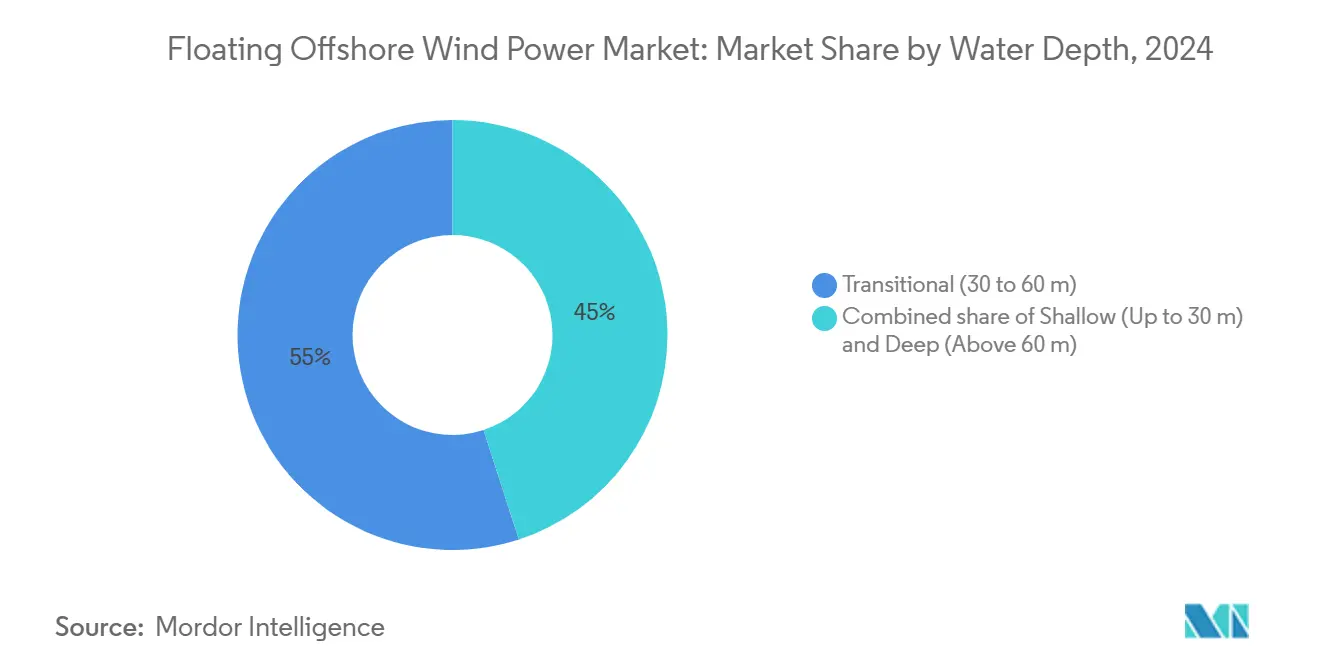
Note: Segment shares of all individual segments available upon report purchase
By Floating Platform Type: Semi-Submersibles Hold Lead, Spar-Buoys Accelerate
Semi-submersibles commanded a 57% share in 2024 after WindFloat Atlantic and Kincardine amassed 150,000+ operating hours, satisfying lender due diligence hurdles. However, Spar-Buoy concepts are projected to achieve an 84% CAGR by 2030, as Equinor’s Hywind design demonstrates that its single-cylinder architecture can reduce steel tonnage by 20-30% per MW and eliminate the need for heavy-lift cranes. Platform rivalry pivots on seabed geology: semi-submersibles favor drag-embedment anchors for soft clays, whereas Spar Buoys suit suction-bucket anchors in hard rock, prevalent in Norway and Japan. Hexicon’s TwinWind dual-turbine semi-submersible secured 100 MW in Ulsan, halving mooring line counts at the cost of added operational complexity. BW Ideol’s Damping Pool internal columns trimmed platform motion, easing cable fatigue and extending design life to match turbine replacement cycles. Hybrid concepts aiming for 40% cost reductions by combining semi-submersible stability with Spar efficiencies exemplify a technology convergence that broadens options for the floating offshore wind power market.
By Turbine Capacity: Larger Machines Slash Balance-of-Plant Costs
Turbines above 15 MW will advance at an 84% CAGR from 2025-2030 as Siemens Gamesa, MingYang, and Vestas commercialize 18-22 MW prototypes that reduce platforms per gigawatt by 30% and cut dynamic cable counts by the same margin. The 5-10 MW class held a 53% stake in 2024, thanks to early Scottish and Norwegian arrays; however, it now represents an economic dead end as developers chase scale economies. Ultra-large rotors mesh well with the low natural frequencies of floating platforms, preserving fatigue life even as hub heights surpass 150 m. Direct-drive permanent-magnet generators in Goldwind’s 16 MW machine lower O&M costs by 18-22%, while Vestas’s 20 MW boost mode lifts capacity factors from 48% to 54% in the North Sea. Larger turbines thus anchor cost-parity milestones, reinforcing the competitiveness of the floating offshore wind power market in transitional depths of 40-60 m.
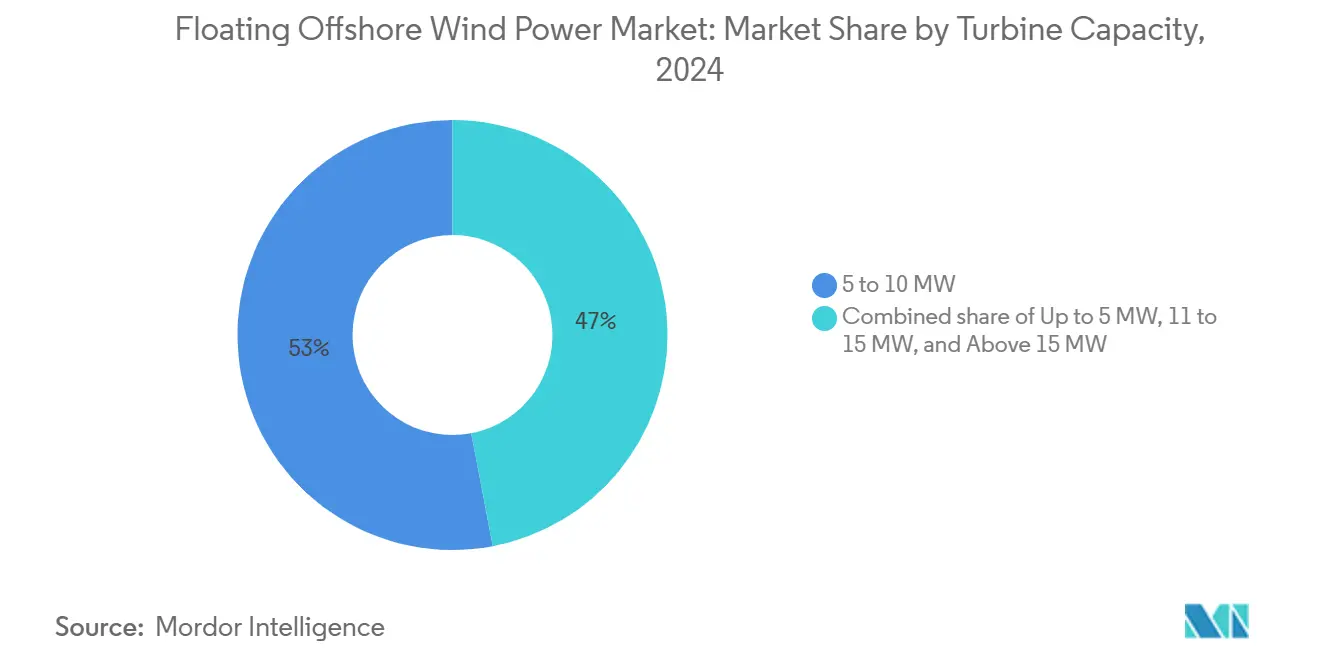
Note: Segment shares of all individual segments available upon report purchase
By Application Stage: Commercial Utility-Scale Achieves Bankability
Pilots below 100 MW captured 68% of the installed capacity in 2024, but the floating offshore wind power market is expected to pivot toward 500-1,400 MW commercial arrays from 2025 onward, as lenders accept debt ratios of 65-70% backed by 25-year contracts. Ørsted’s 1.4 GW Green Volt project closed in November 2024 at GBP 58/MWh LCOE by standardizing 78 semi-submersible platforms with 18 MW turbines. TotalEnergies’ 750 MW EolMed couples a 50 MW battery to stack ancillary services revenues, improving IRR by 180 bp. The expansion of the fabrication yard from eight facilities in 2023 to 14 in 2025 reduced hull lead times from 24 to 16 months, compressing construction schedules and fostering confidence among financiers who now view floating wind as a bankable investment.
Geography Analysis
Europe maintained a commanding 92% share of global deployments in 2024, with a floating offshore wind market size close to 220 MW. Mature engineering clusters in Norway, Scotland, and Portugal underpin this lead, while the UK’s 50 GW total offshore wind ambition, 5 GW of which must be floating by 2030, anchors forward pipelines. State-backed grants, such as the GBP 160 million Floating Offshore Wind Manufacturing Investment Scheme, funnel capital expenditure (capex) toward blade, tower, and mooring plants, thereby shortening delivery times. Norway’s Hywind Tampen has already demonstrated concrete CO₂ savings by electrifying petroleum platforms, solidifying government and public buy-in. France is following with Mediterranean tenders that favor local fabrication yards in Fos-sur-Mer and Port-la-Nouvelle, expanding regional industrial footprints.
Asia-Pacific is the fastest-growing theatre, registering a 156% CAGR as island nations seek deeper-water options where continental shelf widths are minimal. Japan’s target of 5.7 GW by fiscal 2030 and 45 GW by 2040 relies heavily on floating foundations; its seabed surveys identify 424 GW of theoretical resource above 10 m/s wind speeds. South Korea’s 1.8 GW procurement round near Ulsan promises to ignite a specialized supply base encompassing chains, suction anchors, and heavy-lift barges. Taiwan positions itself as a non-China alternative for blades and nacelles, leveraging tax incentives inside its Port of Taichung free-trade zone. China itself dominates fixed-bottom additions, but provincial authorities from Guangdong to Zhejiang are cataloging floating wind corridors exceeding 80 m in depth to diversify coastal load centers.
North America ramps up under the Biden-Harris Administration’s 30 GW offshore wind and 15 GW floating targets. California’s twin lease zones at Morro Bay and Humboldt could host enough capacity to power 5.5 million households, but Endangered Species Act safeguards for the North Atlantic right whale prolong permitting cycles along the broader Pacific Coast. The Gulf of Mexico’s milder sea states and dense brownfield infrastructure make it an attractive early-mover candidate, with oil majors repurposing jack-up rigs as temporary welding stations. Canada monitors the sector’s progress while awaiting turbine icing studies before setting national quotas, whereas Mexico explores policy incentives to integrate floating wind with existing gas-fired peakers on the Baja Peninsula. Collectively, North American projects account for more than 40 GW of auctioned potential, a base that will materially widen the floating offshore wind market after 2027.
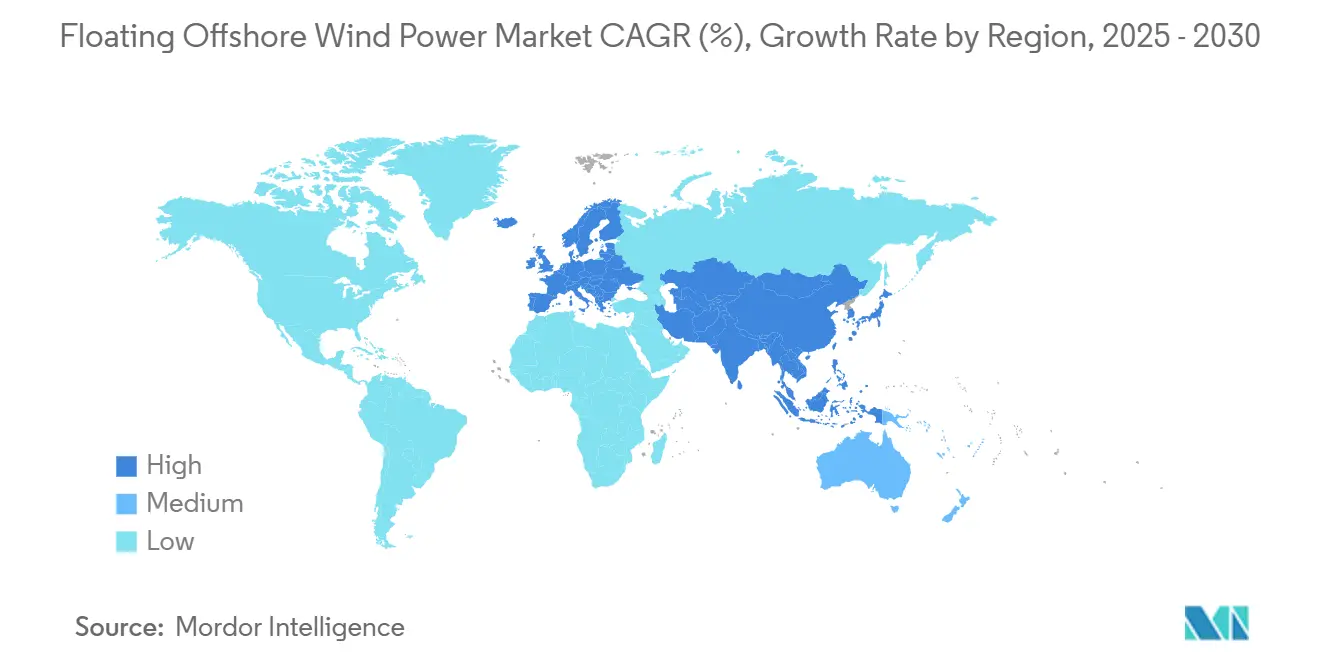
Competitive Landscape
Turbine OEM concentration is notable, with Siemens Gamesa, Vestas, and GE Vernova commanding 70% of the global floating-project pipeline. However, they face price pressure from MingYang and Goldwind, whose 18-22 MW prototypes arrive earlier and at cost discounts in Asia. Platform developers Principle Power, BW Ideol, and Hexicon hold scarce DNV certificates, sustaining engineering margins of over 20%, though Chinese and Korean shipyards are cultivating indigenous designs to bypass license fees. Energy majors Equinor, TotalEnergies, and Shell secure early options by acquiring minority stakes in platform firms and gaining visibility into the turbine supply chain, underscoring their strategic vertical integration.
Localization mandates in Japan and South Korea grant firms like Doosan Enerbility and Marubeni 30-40% of the project value, despite shorter track records, reshaping competitive hierarchies, and fostering regional partnerships. Subsea 7, with a global cable-laying fleet and mooring expertise, replaces conceptual players to deliver balance-of-plant certainty at a gigawatt scale, answering developer demand for large-ticket execution capacity. IP filings, such as RWE’s floating substation with integrated battery and hydrogen electrolyzer, reveal how incumbents now compete through system-level innovation rather than solely on turbine price. The floating offshore wind power market thus balances moderate concentration at the technology layer with intensifying rivalry across regional supply chains and hybrid power-to-X solutions.
Floating Offshore Wind Power Industry Leaders
-
General Electric Company
-
Vestas Wind Systems A/S
-
Siemens Gamesa Renewable Energy, S.A
-
BW Ideol AS
-
Equinor ASA
- *Disclaimer: Major Players sorted in no particular order
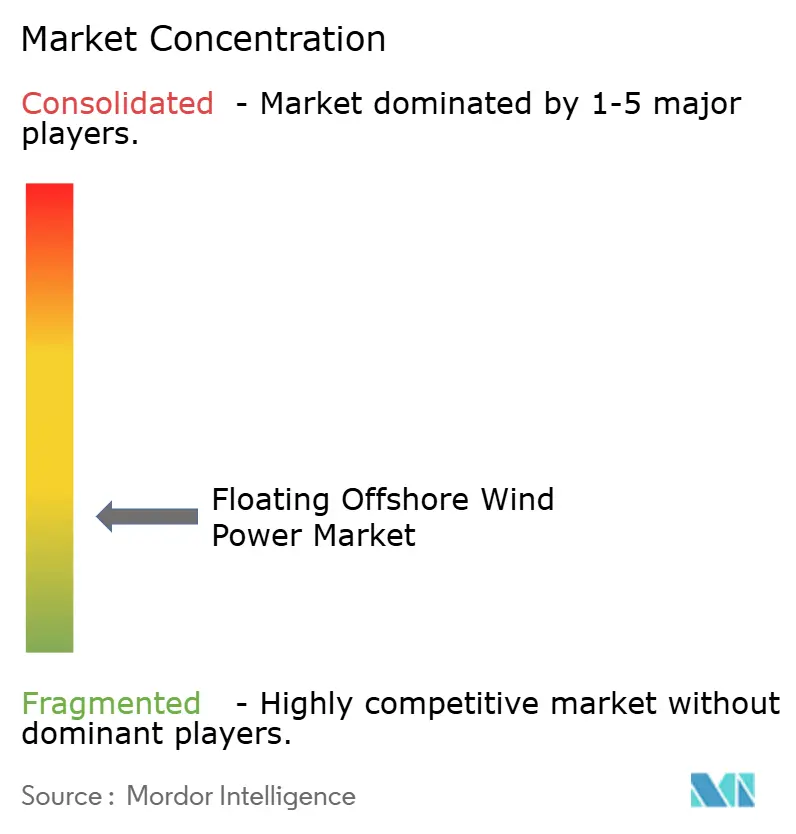
Recent Industry Developments
- June 2025: DNV, a global leader in wind energy technology certification, has signed a memorandum of understanding (MoU) with Japan's Floating Offshore Wind Technology Research Association (FLOWRA) to explore collaborative opportunities in the development of floating wind technology.
- April 2025: The UK government announced a GBP 300 million package for domestic offshore wind supply chains, spanning turbine components, floating platforms, and subsea cables.
- April 2025: China Power, Tokyu Land Corporation, and Renewable Japan commenced commercial operation of the 3 MW Hibiki-nada barge-type floating wind plant, Japan’s first of its kind.
- March 2025: The UK government has allocated more than £ 55 million for Port of Cromarty Firth upgrades, enabling the serial production of floating turbines and creating up to 1,000 skilled jobs.
Research Methodology Framework and Report Scope
Market Definitions and Key Coverage
Our study defines the floating offshore wind power market as all grid-connected wind turbines installed on buoyant, moored platforms that operate in waters deeper than thirty meters, with market size measured in commissioned capacity (MW) as well as their associated revenue pools.
Scope Exclusion: Near-shore fixed-foundation projects in depths below thirty meters are excluded.
Segmentation Overview
- By Water Depth
- Shallow (Up to 30 m)
- Transitional (30 to 60 m)
- Deep (Above 60 m)
- By Floating Platform Type
- Semi-Submersible
- Spar-Buoy
- Tension-Leg Platform (TLP)
- Barge & Hybrid Concepts
- By Turbine Capacity
- Up to 5 MW
- 5 to 10 MW
- 11 to 15 MW
- Above 15 MW
- By Application Stage
- Pre-Commercial Pilot
- Commercial Utility-Scale
- Hybrid Wind-to-X (Hydrogen, Desalination)
- By Geography
- North America
- United States
- Rest of North America
- Europe
- France
- United Kingdom
- Spain
- Nordic Countries
- Italy
- Rest of Europe
- Asia-Pacific
- China
- Japan
- South Korea
- Rest of Asia-Pacific
- South America
- Brazil
- Argentina
- Rest of South America
- Middle East and Africa
- United Arab Emirates
- Saudi Arabia
- South Africa
- Rest of Middle East and Africa
- North America
Detailed Research Methodology and Data Validation
Primary Research
During 2025, we interviewed turbine OEM engineers, mooring contractors, port managers, and power-offtake planners across Europe, Asia-Pacific, and North America. Their insights helped us confirm average turbine ratings, commissioning lags, and achievable load factors, which we then used to temper aspirational project schedules published online.
Desk Research
Mordor analysts first gather foundational numbers from open datasets such as IRENA, GWEC annual capacity tallies, Eurostat renewable statistics, and U.S. DOE offshore wind market reports, which outline national pipelines, auction results, and commissioning dates. Policy documents by the European Commission, the UK Crown Estate, and BOEM supply target trajectories and lease specifics that anchor the capacity build-out curves. Industry journals and port authority cargo logs help us approximate nacelle movements and blade exports that signal actual installations. We layer this with paywalled intelligence pulled from D&B Hoovers for company financials and Dow Jones Factiva for investment announcements to cross-check project valuations. The sources listed are illustrative; many additional publications and datasets inform the desk phase.
A second pass mines patent filings via Questel and shipment traces from Volza to validate technology diffusion and hardware flow, letting us isolate genuine turbine deployments from mere press releases. Where gaps persist, we consult Aviation Week and IMTMA libraries for steel and composite cost indices used to sanity-check capex assumptions.
Market-Sizing & Forecasting
A top-down installed-capacity reconstruction is built from government targets and announced project pipelines, which are then stress-tested with selective bottom-up supplier roll-ups for the five largest arrays. Drivers such as average turbine rating, water-depth mix, floating platform choice, capacity factor progression, steel price trends, and lease-to-COD cycle length feed a multivariate regression that projects capacity through 2030. Missing sub-municipal data, when encountered, is bridged using regional penetration ratios benchmarked against analogous fixed-bottom builds.
Data Validation & Update Cycle
Outputs run through variance checks against IRENA and GWEC time-series, after which a senior reviewer challenges anomalies. Models refresh annually, with off-cycle updates triggered by final investment decisions, turbine order backlogs, or policy shifts. Just before publication, an analyst reruns the latest numbers so clients receive a current snapshot.
Why Mordor's Floating Offshore Wind Power Baseline Earns Trust
Published figures for this young sector often diverge because providers mix revenue and capacity metrics, bundle fixed-bottom assets, or apply aggressive learning-curve multipliers. Our team anchors estimates to physically installed megawatts and moderates long-range growth using country-specific supply-chain constraints, which makes Mordor's view naturally more conservative yet dependable for planning.
Key gap drivers include: a) differing unit of account (capacity versus dollar value), b) inclusion of speculative license areas that lack grid agreements, and c) currency and inflation adjustments applied inconsistently across multiyear models.
Benchmark comparison
| Market Size | Anonymized source | Primary gap driver |
|---|---|---|
| 0.39 GW (2025) | Mordor Intelligence | - |
| USD 1.7 B (2025) | Global Consultancy A | Mixes revenue of component vendors with capacity, lacks deployment cut-off date |
| USD 0.37 B (2024) | Trade Journal B | Counts prototypes and optioned leases, excludes Asia-Pacific cost inflation |
In short, Mordor's stepwise capacity tracking, tempered assumptions, and annual refresh cadence supply decision-makers with a transparent baseline that links directly to verifiable turbines in the water.
Key Questions Answered in the Report
What is the global capacity outlook for floating offshore wind by 2030?
Installed capacity is projected to climb from 390.70 MW in 2025 to 7,690.33 MW in 2030, equating to an 81.48% CAGR.
Why are turbines above 15 MW becoming popular in floating projects?
Larger turbines cut the number of foundations needed, drive LCOE toward €50-100/MWh, and improve project IRRs by spreading fixed costs over greater energy output.
What are the main bottlenecks slowing deployment?
Shortages of suitable installation vessels and reliability issues with high-voltage dynamic cables are the two most significant near-term constraints.
Why are vessel shortages a concern for developers?
Only 28 suitable installation vessels existed in 2024 versus a need for 45-50 by 2028, pushing day rates above USD 450,000 and threatening schedule delays.
How are 18+ MW turbines affecting project economics?
They reduce platform counts by around 30%, cut balance-of-plant scope, and lower levelized costs by EUR 8-12 per MWh.
Can floating wind pair with hydrogen production?
Yes, co-location with offshore electrolysis secures offtake, raises IRR by 200-300 bp, and features in projects like the Dutch Porthos backbone.
Page last updated on:
